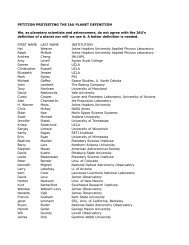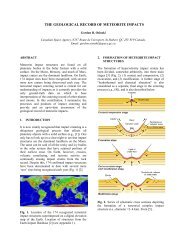Instrument calibration of the Hayabusa near-infrared spectrometer
Instrument calibration of the Hayabusa near-infrared spectrometer
Instrument calibration of the Hayabusa near-infrared spectrometer
Create successful ePaper yourself
Turn your PDF publications into a flip-book with our unique Google optimized e-Paper software.
<strong>Instrument</strong> <strong>calibration</strong> <strong>of</strong> <strong>the</strong> <strong>Hayabusa</strong> <strong>near</strong>-<strong>infrared</strong> <strong>spectrometer</strong>Masanao AbeInstitute <strong>of</strong> Space and Astronautical ScienceJapan Aerospace Exploration Agency3-1-1 Yoshinodai, SagamiharaKanagawa 229-8510, JapanYasuhiko TakagiAichi Toho University3-11 Heiwagaoka, Meito-kuNagoya 465-8515, JapanShinsuke AbeInstitute <strong>of</strong> AstronomyNational Central University300 Jhongda Rd, JhongliTaoyuan 32001, TaiwanKohei KitazatoDepartment <strong>of</strong> Earth and Planetary SciencesKobe University1-1 Rokkodai, Nada-kuKobe 657-8501, Japan26 Manuscript Pages9 Figures1 Tables1
Proposed Running Head: <strong>Hayabusa</strong> NIRS <strong>calibration</strong>Corresponding Author:Masanao AbeInstitute <strong>of</strong> Space and Astronautical ScienceJapan Aerospace Exploration Agency3-1-1 Yoshinodai, SagamiharaKanagawa 229-8510, JapanPhone: +81-42-759-8189Fax: +81-42-759-8457Email: abe@planeta.sci.isas.jaxa.jp2
AbstractThe <strong>Hayabusa</strong> Near-Infrared Spectrometer (NIRS) performed a comprehensive series <strong>of</strong>in-flight tests to validate its preflight radiometric characteristics and to characterizeinstrument stability, pointing, and co-alignment with o<strong>the</strong>r instruments under flight conditions.The results <strong>of</strong> <strong>the</strong>se tests form <strong>the</strong> basis <strong>of</strong> <strong>the</strong> NIRS data reduction and <strong>calibration</strong> procedureand should support <strong>the</strong> ability <strong>of</strong> NIRS to achieve its science goal <strong>of</strong> spectrally mapping<strong>Hayabusa</strong>’s target asteroid, 25143 Itokawa. Main results include <strong>the</strong> following: (1)Radiometric <strong>calibration</strong> <strong>of</strong> NIRS has been confirmed to be accurate to within 5%, based onNIRS measurements <strong>of</strong> astronomical targets and comparisons to radiances derived from <strong>the</strong>ground-based optical instruments; (2) The radiometric response had been stable on <strong>the</strong> scale<strong>of</strong> months and <strong>the</strong> gradual changes in detector sensitivity over 2 years <strong>of</strong> operations in spacemay have been demonstrated by slight displacement <strong>of</strong> <strong>the</strong> detector arrays; (3) Theunexpected stray lights on NIRS spectra were characterized by in-flight experiences; (4) Theco-alignment <strong>of</strong> NIRS with respect to <strong>the</strong> o<strong>the</strong>r <strong>Hayabusa</strong> instruments has been determined.Key Words: instrumentation; asteroids, composition; spectroscopy; <strong>Hayabusa</strong>3
1. IntroductionThe Near-Infrared Spectrometer (NIRS) instrument on <strong>the</strong> <strong>Hayabusa</strong> had acquired morethan 80,000 spatial-resolved spectra <strong>of</strong> <strong>the</strong> asteroid Itokawa through <strong>the</strong> rendezvous operation.The primary objectives <strong>of</strong> NIRS investigations include mapping <strong>the</strong> composition anddistribution <strong>of</strong> surface minerals at spatial resolutions as high as a few ten meters based ondiagnostic absorption features <strong>of</strong> <strong>the</strong> rock-forming minerals (Abe et al., 2006). NIRS datacomplement high-resolution images from <strong>the</strong> multiband imaging camera (AMICA) (Saito etal., 2006), and low spatial resolution elemental distribution from <strong>the</strong> X-ray <strong>spectrometer</strong>(XRS) (Okada et al., 2006) for identification <strong>of</strong> <strong>the</strong> materials composing Itokawa’s surface.This information toge<strong>the</strong>r would constrain <strong>the</strong> history <strong>of</strong> geologic processes that formed <strong>the</strong>asteroid, and determine <strong>the</strong> links between materials composing <strong>the</strong> asteroid and <strong>the</strong>irmeteorite analogs.The <strong>Hayabusa</strong> spacecraft was successfully launched by <strong>the</strong> fifth Mu V launch vehicle onMay 9, 2003. After <strong>the</strong> one-year orbital loop around <strong>the</strong> Sun, <strong>the</strong> spacecraft returned to Earthfor a close flyby on May 20, 2004, obtaining a gravity assist that raises <strong>the</strong> heliocentric orbitenergy and changes <strong>the</strong> orbital inclination. During <strong>the</strong> Earth flyby, <strong>Hayabusa</strong> passed within3700 km <strong>of</strong> Earth’s surface and <strong>the</strong> onboard instruments performed observations <strong>of</strong> <strong>the</strong> Earthand Moon. More than one-year later, on September 12, 2005, <strong>Hayabusa</strong> reached <strong>the</strong> targetasteroid Itokawa and begun three-month rendezvous operations. Currently, <strong>the</strong> spacecraft hasbeen planned to return to Earth in 2010.Successfully achieving <strong>the</strong> scientific goals requires a high degree <strong>of</strong> accuracy andprecision in <strong>the</strong> <strong>calibration</strong> <strong>of</strong> NIRS spectra. A <strong>calibration</strong> was derived for NIRS based onextensive preflight laboratory measurements. During flight operations leading up to Itokawa,we acquired additional in-flight <strong>calibration</strong> data that have allowed us to augment, extend, andenhance <strong>the</strong> quality <strong>of</strong> calibrated NIRS spectra. This paper describes <strong>the</strong> methods and resultsfor <strong>the</strong>se NIRS <strong>calibration</strong> activities, and provides <strong>the</strong> instrumental and data set information.The raw NIRS spectral data observed during <strong>the</strong> flight and rendezvous operations have beenarchived and distributed through <strong>the</strong> JAXA’s <strong>Hayabusa</strong> Science Data Archive(http://darts.isas.jaxa.jp/planet/project/hayabusa/).2. <strong>Instrument</strong> DescriptionThe NIRS is composed <strong>of</strong> a grating <strong>infrared</strong> <strong>spectrometer</strong> (NIRS-S), a <strong>spectrometer</strong>electronics (NIRS-E) and a data processing unit to control NIRS, which is also used tooperate <strong>the</strong> <strong>Hayabusa</strong> XRS. The NIRS-S is mounted on -Y panel inside surface <strong>of</strong> <strong>the</strong>4
spacecraft chassis in such a way that <strong>the</strong> viewing is fixed in almost <strong>the</strong> spacecraft −Z axis,direction in which opposite <strong>the</strong> solar arrays and high-gain antenna (see Fujiwara et al., 2000).The NIRS optical design, summarized in Figure 1, consists <strong>of</strong> an entrance aperture stop,a field stop slit, two mirrors, a diffraction grating, a camera lens assembly, a detector, and two<strong>calibration</strong> targets. The assembled <strong>spectrometer</strong> is covered with carbon-fiber reinforcedplastic box case (300 × 150 × 100 mm in size). After passing through <strong>the</strong> slit, incident light isdispersed by a grism, transmission diffraction grating, combined with a cross disperser andre-imaged <strong>of</strong>f by a camera optics. The first-order light fall on a 64-elementindium-gallium-arsenide (InGaAs) li<strong>near</strong> detector array that covers <strong>the</strong> range <strong>of</strong> 750-2250 nm,in increments <strong>of</strong> 24 nm. The cross disperser prevents light o<strong>the</strong>r than first-order from reaching<strong>the</strong> detector. NIRS carries <strong>the</strong> two types <strong>of</strong> onboard <strong>calibration</strong> targets, an incandescenthalogen lamp and a light-emitting-diode (LED), for periodic monitoring <strong>of</strong> detector stability.These targets are mounted on <strong>the</strong> aperture plate. The design was developed in accordancewith <strong>the</strong> requirements <strong>of</strong> downsizing and weight saving.Table 1 lists key specifications and characteristics <strong>of</strong> <strong>the</strong> instrument. Note that <strong>the</strong><strong>calibration</strong> LED is fixed outside <strong>of</strong> aperture but <strong>the</strong> lamp is fixed on <strong>the</strong> inner edge <strong>of</strong> apertureso that <strong>the</strong> effective aperture size drop <strong>of</strong>f by ~4%. The slit size was determined as it canprovide an angular field-<strong>of</strong>-view (FOV) <strong>of</strong> 0.1° × 0.1°, which corresponds to <strong>the</strong> spatialresolution <strong>of</strong> 17 m × 17 m at a distance <strong>of</strong> 10 km. A moveable shutter can be used to blockcompletely <strong>the</strong> slit for dark current measurements. The signal in a dark spectrum represents<strong>the</strong> background electronic and o<strong>the</strong>r noise inherent in <strong>the</strong> instrument. A <strong>the</strong>rmoelectric Peltierdevice actively cools <strong>the</strong> InGaAs detector arrays in order to achieve a sufficientsignal-to-noise ratio (SNR). The detector has a built-incomplementary-metal-oxide-semiconductor (CMOS) image sensor, which is used tomultiplex <strong>the</strong> outputs to a single analog to digital (A/D) converter.3. Operating Modes and Data AcquisitionNIRS operation modes are implemented in <strong>the</strong> onboard s<strong>of</strong>tware using instrumentparameters that can be changed by ground operation commands. There are a total <strong>of</strong> fivemodes available to NIRS; NORMAL, RAW, HIST, LIDAR, and FLASH.In <strong>the</strong> NORMAL mode, each observation consists <strong>of</strong> certain sequential sets <strong>of</strong> alternatelight and dark frames (see Figure 2). That is accomplished by chopping-motion <strong>of</strong> <strong>the</strong> shutter,allowing <strong>the</strong> dark current level <strong>of</strong> <strong>the</strong> detector to be subtracted on a channel-by-channel basisevery time. The CMOS image sensor serves to read differences <strong>of</strong> outputs on each detector5
element between light and dark frames. The NIRS frame length is 65.536 ms, whichcorresponds to half <strong>of</strong> <strong>the</strong> shutter driving cycle, and exposure time can be changed at256-stage from 0.256 ms to 57.344 ms. In addition, <strong>the</strong> number <strong>of</strong> stacked light-dark frameset can be also changed from 1 to 2 255 as n-th power <strong>of</strong> two. Most <strong>of</strong> NIRS data were taken inthis mode.The basic unit <strong>of</strong> spectral data for any given NIRS channel is digital number (DN)showing <strong>the</strong> integrated photon counts during a setting exposure-time interval. The raw dataare originally sampled with 14 bits per channel (0-16383 DNs). A DN has a value <strong>of</strong>approximately 0.565 mV output from <strong>the</strong> detector pre-amplifiers when at gain 1.08 ×. In <strong>the</strong>NORMAL mode, <strong>the</strong> data averaging <strong>of</strong> light frames subtracted dark spectrum are operatedwith onboard s<strong>of</strong>tware, and only <strong>the</strong> mean, deviation, maximum and minimum <strong>of</strong> <strong>the</strong> DNs atindividual channels were downloaded in instrument telemetry. The RAW mode prohibits <strong>the</strong>data averaging on board <strong>the</strong> spacecraft. The HIST mode provides a sequential output <strong>of</strong> <strong>the</strong>housekeeping (HK) data for NIRS. However, <strong>the</strong> RAW and HIST modes have not been usedin reality until <strong>the</strong> completion <strong>of</strong> <strong>the</strong> asteroid observation.The LIDAR and FLASH modes were supposed to be used in <strong>the</strong> descent andtouchdown phase during <strong>the</strong> <strong>Hayabusa</strong> rendezvous with Itokawa. In <strong>the</strong> LIDAR mode, NIRScarries out <strong>the</strong> frame difference readout in sync with <strong>the</strong> periodic laser pulse <strong>of</strong> LIDAR (alaser ranging instrument on <strong>the</strong> <strong>Hayabusa</strong>) so as to observe <strong>the</strong> reflected laser light <strong>of</strong> <strong>the</strong>LIDAR from <strong>the</strong> asteroid surface. The shutter stays open during this observation mode. On<strong>the</strong> o<strong>the</strong>r hand, <strong>the</strong> FLASH mode was designed to remove <strong>the</strong> frame contaminated byflashlights to irradiate target markers for autonomous navigation <strong>of</strong> sampling. This mode isidentical to <strong>the</strong> NORMAL mode, excluding <strong>the</strong> removal <strong>of</strong> <strong>the</strong> synchronized frame withflashlights.4. Pre-launch Calibration and CharacterizationThe NIRS instrument was tested and calibrated extensively at <strong>the</strong> piece-part andinstrument levels to verify its performance and to define its operational characteristics tolevels required to meet <strong>the</strong> science objectives. The tests and <strong>calibration</strong>s were carried out atambient and vacuum chamber conditions. Also <strong>the</strong> instrument underwent extensivevibrational and <strong>the</strong>rmal vacuum testing.The ground testing and <strong>calibration</strong>s <strong>of</strong> NIRS were conducted primarily at <strong>the</strong> Institute <strong>of</strong>Space and Astronautical Science (ISAS), Japan. The tests at <strong>the</strong> piece-part level includedmeasurements <strong>of</strong> detector li<strong>near</strong>ity, responsivity as functions <strong>of</strong> wavelength and temperature6
(Figure 3), dark current characteristics and spectral transmission properties <strong>of</strong> <strong>the</strong> grating(Figure 4).<strong>Instrument</strong>-level <strong>calibration</strong>s <strong>of</strong> NIRS included measurements <strong>of</strong> <strong>the</strong> responsivity as afunction <strong>of</strong> wavelength and FOV <strong>of</strong> each detector element (to verify detector li<strong>near</strong>ity andalignment and to yield spectral resolution, spatial resolution, and flux <strong>calibration</strong> data),characterization <strong>of</strong> dark current levels for each detector element as a function <strong>of</strong> temperature,characterization <strong>of</strong> <strong>the</strong> level <strong>of</strong> spectral crosstalk on detector channels, and electronicperformance characteristics <strong>of</strong> <strong>the</strong> detector arrays. Finally, measurements <strong>of</strong> <strong>the</strong> <strong>calibration</strong>targets and some <strong>of</strong> mineral and rock samples were made with <strong>the</strong> assembled NIRSinstrument. The NIRS <strong>calibration</strong>s show that <strong>the</strong> detectors are li<strong>near</strong> and well aligned and that<strong>the</strong> instrument operates at very close to its design parameters for spatial and spectralresolution.4.1 Spectral CalibrationSpectral <strong>calibration</strong> was conducted in order to establish <strong>the</strong> wavelengths sensed by adetector for each <strong>of</strong> <strong>the</strong> 64 possible grating positions. That was performed by illuminating <strong>the</strong>instrument aperture with <strong>the</strong> monochromator, which is used in conjunction with anincandescent source and an integrating sphere. The signals from <strong>the</strong> detector arrays wererecorded with <strong>the</strong> monochromator wavelength scanned in 100 nm increments over <strong>the</strong>first-order wavelength range. The spectral <strong>calibration</strong> was performed under <strong>the</strong> ambienttemperature <strong>of</strong> 2°C. The results in <strong>the</strong> laboratory final test are shown in Figure 5. This figureshows <strong>the</strong> central wavelength <strong>of</strong> each <strong>of</strong> <strong>the</strong> detector arrays and <strong>the</strong> channel-to-wavelengthrelationship is expressed by:(1)where n is <strong>the</strong> channel number between 1 to 64. The accuracy <strong>of</strong> this equation for li<strong>near</strong>fitting is approximately ± 2 nm.Although <strong>the</strong> full range <strong>of</strong> <strong>the</strong> NIRS detector array is 751.8 to 2259.7 nm, it is fur<strong>the</strong>rlimited, however, to 850 to 2100 nm (channels 7-60). The lower six channels (channels 1-6, at2248-2130 nm) are <strong>near</strong> or in <strong>the</strong> detector cut<strong>of</strong>f (Figure 3), making <strong>the</strong> effective upper boundfor good signal-to-noise ratio (SNR) around 2100 nm for <strong>the</strong> signal level expected at Itokawa.The upper four channels <strong>of</strong> <strong>the</strong> InGaAs detector (channels 61-64, at 834-763 nm) register verylow signal due to fall-<strong>of</strong>f in detector responsivity and grism efficiency.7
4.2 Radiometric CalibrationThe radiometric response <strong>of</strong> <strong>the</strong> NIRS was determined in a number <strong>of</strong> tests by recording<strong>the</strong> detector response while viewing a laboratory calibrated field with a halogen lamp and aSpectralon reflectance target. The measurements used a 1 kW filament lamp with a quartzenvelope containing halogen gas. The spectral radiance <strong>of</strong> this source has been calibrated by<strong>the</strong> Oriel <strong>Instrument</strong>s and this <strong>calibration</strong> is directly traceable to <strong>the</strong> National Institute <strong>of</strong>Standards and Technology (NIST). The lamp was powered by regulated direct current at <strong>the</strong>prescribed amperage, measured using NIST-traceable instruments. In order to produce anextended source <strong>of</strong> known radiance, we used a Labsphere Spectralon standard, itselfcalibrated with traceability to NIST.The per-channel DN-to-radiance conversion factor <strong>of</strong> <strong>the</strong> NIRS is shown in Figure 6.The response <strong>of</strong> <strong>the</strong> instrument was found to be li<strong>near</strong> and uncertainties <strong>of</strong> <strong>the</strong> NIRS absoluteradiometric <strong>calibration</strong> <strong>of</strong> were estimated to be approximately 10% in <strong>the</strong> effectivewavelength range. Though <strong>the</strong> <strong>calibration</strong> was performed under <strong>the</strong> ambient condition, weapplied <strong>the</strong> correction <strong>of</strong> atmospheric water vapor using <strong>the</strong> MODTRAN s<strong>of</strong>tware. The NIRSradiometric <strong>calibration</strong>s showed that for radiances expected at Itokawa, a signal-to-noise ratio(SNR) in excess <strong>of</strong> 100 is easily attainable in 57 InGaAs channels (from 2 to 58) withnominal detector temperature <strong>of</strong> -15°C. Since <strong>the</strong> detector temperature was maintained in analmost constant value in flight, except for caltarget observations, no temperature correction isrequired for <strong>the</strong> radiometric <strong>calibration</strong>.4.3 Spatial CalibrationAlignment <strong>of</strong> <strong>the</strong> boresights <strong>of</strong> <strong>the</strong> <strong>Hayabusa</strong> scientific instruments relative to eacho<strong>the</strong>r and to <strong>the</strong> nominal common boresight, <strong>the</strong> spacecraft –Z axis (<strong>the</strong> Z axis isperpendicular to <strong>the</strong> plane <strong>of</strong> <strong>Hayabusa</strong>’s solar panels, and +Z direction on <strong>the</strong> spacecraftpoints toward <strong>the</strong> Sun with <strong>the</strong> spacecraft in its nominal orientation), were measured onground, after spacecraft integration, using <strong>the</strong> reference optical cubes on each instrument. ForNIRS, <strong>the</strong> accurate boresight vector was found to be inclined toward <strong>the</strong> spacecraft –Z axiswith <strong>the</strong> Euler angles (-0.1140°, -0.0012°, 0.0°) and was verified <strong>the</strong> co-alignment withLIDAR. The FOV has rectangular shape with its sides along X and Y axes <strong>of</strong> <strong>the</strong> instrumentsframe and <strong>the</strong> angular size <strong>of</strong> 0.1°.As <strong>the</strong>se measurements were done under conditions <strong>of</strong> 1g and room temperature,conditions experienced by <strong>Hayabusa</strong> in space will distort <strong>the</strong> coalignment between8
instruments slightly. Coalignment between <strong>the</strong> instruments was re-measured in flight andduring <strong>the</strong> asteroid rendezvous.5. In-flight CalibrationAfter launch, <strong>the</strong> NIRS performed a comprehensive series <strong>of</strong> in-flight tests to validateand supplement ground <strong>calibration</strong> data, and to characterize instrument stability, pointing, andco-alignment with o<strong>the</strong>r instruments under flight conditions. The in-flight observations <strong>of</strong>astronomical targets took place during <strong>the</strong> cruise phase before <strong>the</strong> arriving at Itokawa, withNIRS obtaining spatially resolved spectra <strong>of</strong> <strong>the</strong> Earth and Moon, and disk-integrated spectra<strong>of</strong> <strong>the</strong> Mars, Jupiter, and Saturn, including three bright stars.5.1 Long-term StabilityThe periodic onboard <strong>calibration</strong>-target observations in space assessed <strong>the</strong> long-termstability <strong>of</strong> radiometric and spectral characteristics. Figure 7 shows <strong>the</strong> results for <strong>the</strong> NIRS<strong>calibration</strong>-target observations at a constant detector temperature from after launch to <strong>the</strong>rendezvous, including a <strong>the</strong>rmal vacuum test on ground. Figure 7a presents time series plots<strong>of</strong> relative responses for <strong>the</strong> selected NIRS channels normalized by <strong>the</strong> values obtained onMay 16, 2003. Figure 7b in turn presents time series plots <strong>of</strong> <strong>the</strong> NIRS channels peaked in <strong>the</strong>LED spectra. The onboard calibrated LED generates a narrow spectrum centered at <strong>the</strong>specific wavelength <strong>of</strong> ~1.8 μ m. Under a constant temperature condition, its peakwavelength does not shift beyond <strong>the</strong> NIRS spectral resolution.Without short-term general increases as in Earth swingby and <strong>the</strong> arrival, <strong>the</strong> plotsshows <strong>the</strong> gradual changes in NIRS channel responses up to ± 3%. The reason for thisbehavior is probably related to spectral alignment <strong>of</strong> <strong>the</strong> detector. Using <strong>the</strong> data <strong>of</strong> detectorwavelength drift, we found that displacement <strong>of</strong> detector channels can generate such changesin <strong>the</strong> detector responses. The general high responsivity as seen in Earth swingby may beoccurred by <strong>the</strong> lamp brightening due to <strong>the</strong> NIRS continuous operation. The rest <strong>of</strong> <strong>the</strong>overall time series corresponds to a gradual decay <strong>of</strong> <strong>the</strong> instrument primarily due to solar andcosmic ray radiation damage to <strong>the</strong> detectors and electronics. In addition, a general loss <strong>of</strong>3-4% <strong>of</strong> NIRS response in <strong>the</strong> detector resulted from <strong>the</strong> launch.The slight changes in instrument sensitivity over two years <strong>of</strong> in-flight operations werefound, but <strong>the</strong> radiometric response had been highly stable on time scale <strong>of</strong> a few months. Theli<strong>near</strong>ities <strong>of</strong> NIRS detector response also were verified from <strong>the</strong> various exposure-timeframes on <strong>the</strong> <strong>calibration</strong>-target observation. Thus, we found that differences in instrument9
sensitivity <strong>of</strong> NIRS for <strong>the</strong> rendezvous phase fall within ~1% for overall effective detectorchannels.5.2 Validation <strong>of</strong> Calibration CoefficientsValidation <strong>of</strong> <strong>the</strong> absolute <strong>calibration</strong> was performed through observations <strong>of</strong> <strong>the</strong>astronomical targets during <strong>the</strong> cruise. Figure 8 shows spectra <strong>of</strong> <strong>the</strong> Antares, Jupiter andMoon observed by <strong>the</strong> NIRS. For comparison, those spectra obtained by <strong>the</strong> ground-basedtelescopes are also shown (Lancon and Wood, 2000; Clark and McCord, 1979). The spectrashow an overall close match between <strong>the</strong> NIRS data and <strong>the</strong> ground-based observations.Stray light from outside <strong>of</strong> <strong>the</strong> FOV was not a major issue with NIRS since it was notidentified in <strong>the</strong> pre-launch test with a blackbody cavity. However, significant strayreflections were found when NIRS had observed across <strong>the</strong> limb <strong>of</strong> Moon (Figure 8c andFigure 9). This may be due to <strong>the</strong> scattered light by <strong>the</strong> <strong>calibration</strong> lamp mounted on <strong>the</strong>aperture stop. The effect was dominant in <strong>the</strong> shorter wavelengths and required correction forproper <strong>calibration</strong> <strong>of</strong> <strong>the</strong> instrument. NIRS <strong>calibration</strong> did not incorporate a scattered lightcorrection from pre-launch tests. The magnitude <strong>of</strong> out-<strong>of</strong>-field signal was quantified byacquiring swaths <strong>of</strong> spectra across <strong>the</strong> limb <strong>of</strong> Moon and Itokawa, during different orbits as<strong>the</strong> source <strong>of</strong> stray light changes in its size and illumination. These results will also beaugmented by <strong>the</strong> results <strong>of</strong> <strong>the</strong> more controlled investigations <strong>of</strong> stray and scattered lightconducted during pre-flight <strong>calibration</strong>s.As for NIRS alignment and pointing, <strong>the</strong> co-alignment <strong>of</strong> NIRS with <strong>the</strong> AMICA andwith respect to <strong>the</strong> spacecraft was determined from <strong>the</strong> simultaneous observations <strong>of</strong> brightstars as a point source. The o<strong>the</strong>r observation was attained during <strong>the</strong> Itokawa rendezvousphase. The NIRS had detected <strong>the</strong> reflected laser light <strong>of</strong> <strong>the</strong> LIDAR from <strong>the</strong> asteroid surfaceduring <strong>the</strong> spacecraft descent (Abe et al., 2006). The LIDAR generates 1064-nmyttrium-aluminus-garnet-Nd (YAG-Nd) laser beam to measure distance by determining <strong>the</strong>time <strong>of</strong> flight for laser light to travel from <strong>the</strong> spacecraft to asteroid and return. The detectedLIDAR spectra have shown <strong>the</strong> peak wavelength same as that obtained in prelaunch.Therefore, we found that <strong>the</strong>re is no alteration <strong>of</strong> <strong>the</strong> NIRS spectral alignment from <strong>the</strong>prelaunch to final stage <strong>of</strong> <strong>the</strong> rendezvous phase. Moreover, LIDAR has a beamwidth <strong>of</strong> 0.04°× 0.097°, and such detection means that LIDAR boresight has been coaligned with NIRS asexpected.5.3 NIRS and AMICA Reflectance Comparison10
Once spectra and images are calibrated and photometrically corrected to a uniformviewing geometry, <strong>the</strong> combination <strong>of</strong> spectra between <strong>the</strong> AMICA and NIRS can create amore complete <strong>near</strong> <strong>infrared</strong> spectrum to better characterize Itokawa’s surface compositionusing absorption band features. To compare <strong>the</strong> absolute <strong>calibration</strong> between both instruments,we have calculated <strong>the</strong> geometric albedo (also known as <strong>the</strong> physical albedo) <strong>of</strong> Itokawa foreach wavelength using <strong>the</strong> set <strong>of</strong> wavelength-dependent Hapke parameters derived from(Kitazato et al., 2008). The geometric albedo, A g , is <strong>the</strong> weighted average <strong>of</strong> <strong>the</strong> normalalbedo (<strong>the</strong> radiance factor <strong>of</strong> <strong>the</strong> surface at zero phase) over <strong>the</strong> illuminated area <strong>of</strong> <strong>the</strong> body(Hapke, 1993), and is written in <strong>the</strong> form(2)where is <strong>the</strong> bidirectional reflectance <strong>of</strong> <strong>the</strong> surface, is <strong>the</strong> increment <strong>of</strong> area,and is <strong>the</strong> area <strong>of</strong> <strong>the</strong> illuminated surface <strong>of</strong> <strong>the</strong> body.Figure 10 shows Itokawa’s geometric albedo spectrum estimated with equation (2),including that value at visible wavelength (0.55 μm) from <strong>the</strong> AMICA measurements(Ishiguro et al., 2007). In this figure, as an intermediary <strong>the</strong> disk-integrated visible to<strong>near</strong>-<strong>infrared</strong> spectra <strong>of</strong> Itokawa obtained by Binzel et al. (2001) and Tholen (2006) aredisplayed in accordance with AMICA. The prospective <strong>near</strong>-<strong>infrared</strong> albedos from <strong>the</strong>AMICA results appear to be approximately 7% larger than <strong>the</strong> real values measured by NIRSindependently. Considering <strong>the</strong> uncertainties <strong>of</strong> absolute <strong>calibration</strong> for both instruments, thisresult can be regarded as a good agreement. As for <strong>the</strong> effect <strong>of</strong> a real asteroid shape on <strong>the</strong>geometric albedo, we found that its variation falls within ~1.5% in <strong>the</strong> case <strong>of</strong> Itokawa.Although <strong>the</strong>re is slight variations in geometric albedo due to different viewpoints, this cannotbe a factor that fills a gap in absolute <strong>calibration</strong> between <strong>the</strong> NIRS and AMICA.6. SummaryNIRS is a crucial component <strong>of</strong> <strong>the</strong> <strong>Hayabusa</strong> instrument complement needed to achieve<strong>the</strong> prime science objectives at <strong>the</strong> S type asteroid 25143 Itokawa. The instrument has beenoperational in space for over two and a half years and has collected abundant data from itsonboard caltargets and observations in flight. NIRS has carried out numerous in-flight tests tovalidate its radiometric characteristics measured on-ground before launch and to characterize<strong>the</strong> instrument's long-term stability, pointing, and co-alignment with LIDAR. Test results11
validate and refine coefficients to convert raw spectral data to scientifically useful calibrateddata products. Main in-flight <strong>calibration</strong> results include <strong>the</strong> following: (1) Radiometriccomparison <strong>of</strong> NIRS with its imaging companion AMICA is good. The two instruments agreeto better than 10% for calculated radiance <strong>of</strong> Itokawa. Independent radiometric <strong>calibration</strong> <strong>of</strong>Antares and Jupiter with <strong>the</strong> ground-based telescopes yielded agreement better than 5%. (2)During <strong>the</strong> long cruise to Itokawa, <strong>the</strong> average responsivity <strong>of</strong> individual NIRS channels hasgradually changed with up to 2% increase in <strong>the</strong> lower wavelength and about 2% decrease in<strong>the</strong> higher wavelengths. This change in responsivity might have resulted from a gradualdisplacement <strong>of</strong> detector arrays. (3) From limb scans <strong>of</strong> Moon and Itokawa, unexpected straylight was found to affect <strong>the</strong> NIRS spectra by up to 2%. In-flight experience allowed us tocalibrate such effects. (4) The co-alignment <strong>of</strong> NIRS with respect to <strong>the</strong> o<strong>the</strong>r <strong>Hayabusa</strong>instruments has been determined.AcknowledgmentsDevelopment <strong>of</strong> <strong>the</strong> NIRS instrument, along with incorporation <strong>of</strong> necessary spacecraftaccommodations, involved <strong>the</strong> work <strong>of</strong> many people. The authors would like to express <strong>the</strong>irthanks to <strong>the</strong> entire NIRS team, whose efforts led to <strong>the</strong> success <strong>of</strong> this instrument on a verytight schedule.12
ReferencesAbe, M., Takagi, Y., Kitazato, K., Abe, S., Hiroi, T., Vilas, F., Clark, B. E., Abell, P. A.,Lederer, S. M., Jarvis, K. S., Nimura, T., Ueda, Y., Fujiwara, A., 2006. Near-InfraredSpectral Results <strong>of</strong> Asteroid Itokawa from <strong>the</strong> <strong>Hayabusa</strong> Spacecraft. Science 312,1334–1338.Abe, S., Mukai, T., Hirata, N., Barnouin-Jha, O. S., Cheng, A. F., Demura, H., Gaskell, R. W.,Hashimoto, T., Hiraoka, K., Honda, T., Kubota, T., Matsuoka, M., Mizuno, T., Nakamura,R., Scheeres, D. J., Yoshikawa, M., 2006. Mass and Local Topography Measurements <strong>of</strong>Itokawa by <strong>Hayabusa</strong>. Science 312, 1344–1349.Binzel, R. P., Rivkin, A. S., Bus, S. J., Sunshine, J. M., Burbine, T. H., 2001. MUSES-C targetasteroid (25143) 1998 SF36: A reddened ordinary chondrite. Meteoritics and PlanetaryScience 36, 1167–1172.Clark, R. N., McCord, T. B., 1979. Jupiter and Saturn - Near-<strong>infrared</strong> spectral albedos. Icarus40, 180–188.Fujiwara, A., Mukai, T., Kawaguchi, J., Uesugi, K. T., 2000. Sample Return Mission to NEA :MUSES-C. Advances in Space Research 25, 231–238.Hapke, B., 1993. Theory <strong>of</strong> reflectance and emittance spectroscopy. Topics in Remote Sensing,Cambridge, UK: Cambridge University Press, —c1993.Ishiguro, M., Nakamura, R., Tholen, D. J., Hirata, N., Demura, H., Nemoto, E., Nakamura, A.M., Higuchi, Y., Sogame, A., Yamamoto, A., Kitazato, K., Yokota, Y., Kubota, T.,Hashimoto, T., Saito, J., 2007. Calibration and Performance <strong>of</strong> Asteroid Multi-bandImaging Camera (AMICA) onboard <strong>Hayabusa</strong> Spacecraft. Icarus -, (submitted).Kitazato, K., Clark, B. E., Abe, M., Abe, S., Takagi, Y., Hiroi, T., Barnouin-Jha, O. S., Abell, P.A., Lederer, S. M., Vilas, F., 2008. Near-<strong>infrared</strong> spectrophotometry <strong>of</strong> Asteroid 25143Itokawa from NIRS on <strong>the</strong> <strong>Hayabusa</strong> spacecraft. Icarus 194, 137–145.Kurucz, R., R. L., 1995. The solar irradiance by computation. Proc. 17 th Annual ConferenceTransmission Models, Phillips Laboratory, Hanscom AFB, PL-TR-95-2060, G. P.Anderson et al. Eds,, pp. 333-334.Lancon, A., Wood, P. R., 2000. A library <strong>of</strong> 0.5 to 2.5 mu m spectra <strong>of</strong> luminous cool stars.A&AS 146, 217–249.Okada, T., Shirai, K., Yamamoto, Y., Arai, T., Ogawa, K., Hosono, K., Kato, M., 2006. X-rayFluorescence Spectrometry <strong>of</strong> Asteroid Itokawa by <strong>Hayabusa</strong>. Science 312, 1338–1341.Saito, J., Miyamoto, H., Nakamura, R., Ishiguro, M., Michikami, T., Nakamura, A. M.,Demura, H., Sasaki, S., Hirata, N., Honda, C., Yamamoto, A., Yokota, Y., Fuse, T.,13
Yoshida, F., Tholen, D. J., Gaskell, R. W., Hashimoto, T., Kubota, T., Higuchi, Y.,Nakamura, T., Smith, P., Hiraoka, K., Honda, T., Kobayashi, S., Furuya, M., Matsumoto,N., Nemoto, E., Yukishita, A., Kitazato, K., Dermawan, B., Sogame, A., Terazono, J.,Shinohara, C., Akiyama, H., 2006. Detailed Images <strong>of</strong> Asteroid 25143 Itokawa from<strong>Hayabusa</strong>. Science 312, 1341–1344.14
Table 1: NIRS SpecificationsCharacteristicValueSpectral range850 – 2100 nmSpectral resolution24 nm/channelDetector element size30 × 100 μmNumber <strong>of</strong> detector elements 64Grating ruling75 grooves/mmSlit size70 × 70 μmField <strong>of</strong> view 0.1°× 0.1°Apertureφ27.2 mmImaging interval65.536 msIntegration time0.256 – 57.344 msShutter driving7.63 Hz (131.072 ms)Size336 × 165 × 100 mm (NIRS-S)Mass1.53 kg (NIRS-S)Power9.50 W (NIRS-S), 0.45 W (NIRS-E)15
Figure 1: Schematic optical design <strong>of</strong> <strong>the</strong> NIRS.Figure 2: NIRS timing chart.16
Figure 3: Spectral responsivity <strong>of</strong> InGaAs detector array depending on temperature.Figure 4: The measured grism efficiency for different spectral orders.17
Figure 5: Spectral <strong>calibration</strong> data and li<strong>near</strong> regression.Figure 6: The radiometric <strong>calibration</strong> <strong>of</strong> <strong>the</strong> NIRS determined from laboratory tests,corresponding to a field filling source.18
Figure 7: Time series plots for (a) <strong>the</strong> NIRS channel responses in lamp observation and (b)<strong>the</strong> peak channels in LED observation.19
Figure 8: Representative NIRS spectra obtained from in-flgith measurements: (a) Antares, (b)Jupiter, (c) Moon. The spectra used for comparison were taken by <strong>the</strong> ground-basedtelescopes (Lancon and Wood, 2000; Clark and McCord, 1979).Figure 9: The image <strong>of</strong> Moon taken by <strong>the</strong> AMICA shows <strong>the</strong> relative position <strong>of</strong> <strong>the</strong>individual observation <strong>of</strong> NIRS. The number in NIRS FOV frames corresponds to that inFigure 8 respectively.20
Figure 10: Comparison <strong>of</strong> <strong>the</strong> derived geometric albedo <strong>of</strong> Itokawa between <strong>the</strong> NIRS andAMICA. The value at V-band (0.55 μm) has been estimated by AMICA (Ishiguro et al.,2007). As an intermediary <strong>the</strong> visible to <strong>near</strong>-<strong>infrared</strong> spectra <strong>of</strong> Itokawa obtained from <strong>the</strong>ground-based observations by Binzel et al. (2001) and Tholen (2006) are plotted withnormalized at <strong>the</strong> value <strong>of</strong> AMICA’s V-band.21


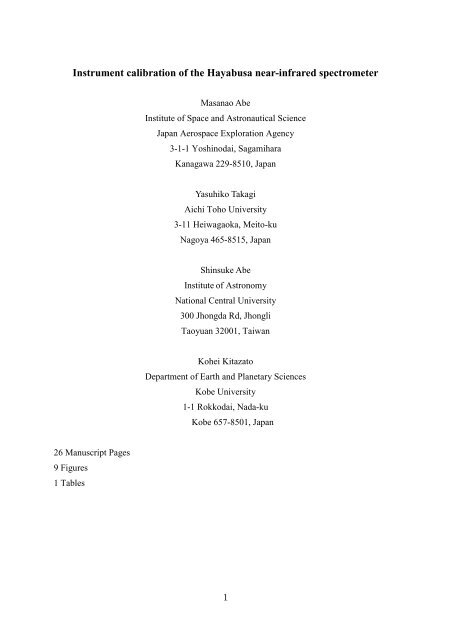
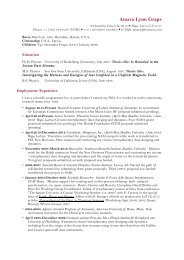
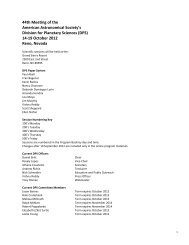
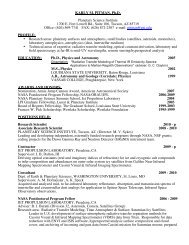
![Large-Aperture [OI] 6300 Ã
Photometry of Comet Hale-Bopp ...](https://img.yumpu.com/37144207/1/190x245/large-aperture-oi-6300-a-photometry-of-comet-hale-bopp-.jpg?quality=85)
